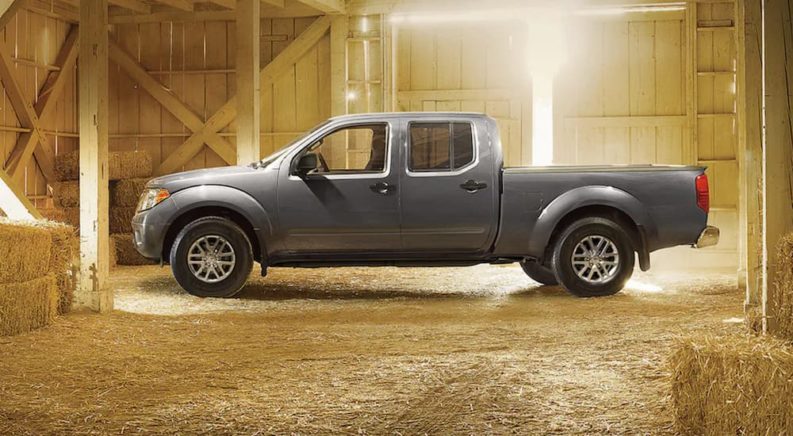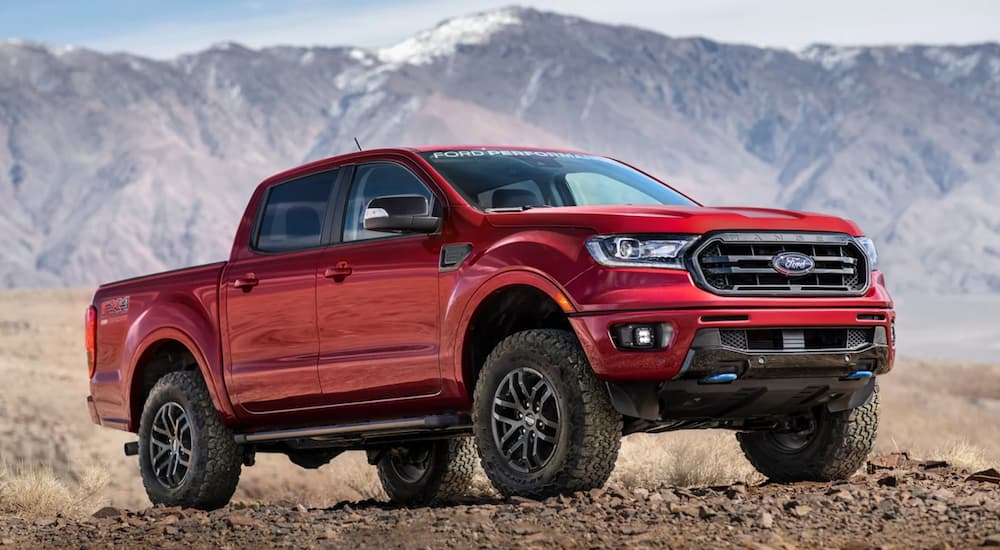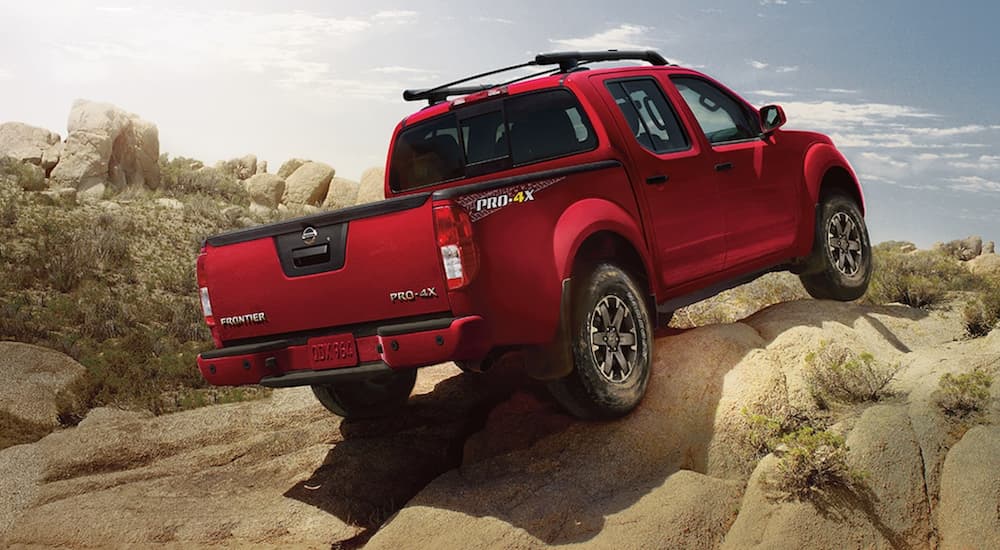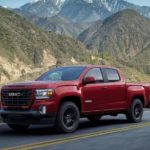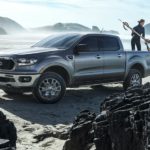What do you get when you cross a nimble and quick sports sedan with a full-size pickup? The answer can be found when you compare a 2021 Nissan Frontier vs 2021 Ford Ranger. The midsize pickup renaissance is upon us, and buyers are taking full advantage of the modest decrease in size to achieve real performance gains. It’s a unique category that bridges the divide between on-road performance and off-roading capability.
Ford put the Ranger through a bumpy now-it’s-there, now-it’s-not, oh-wait-it’s-back generational history, a fact that confounds small pickup fans. Why mess with a nameplate with such a loyal following? No one really knows, except that at the time of its discontinuation in 2012, Ford cited declining sales as the reason. We blame poor marketing and a lack of connection to segment aficionados.
Nissan Frontier fans are a mixed bunch, with many buyers choosing the Titan’s little brother as an SUV alternative rather than for the standalone capabilities that so clearly differentiate it from common vanilla SUVs and crossovers. Among its fan base is a core set of armchair truck experts who know a good thing when they see it and who appreciate Nissan’s commitment to the category.
We wondered which truck, the Ranger or the Frontier, offered the most extraordinary capability and performance. Rather than regurgitating press kit specs, we decided to dig deeper. Here’s what we found.
What’s Under the Nifty Styling?
If it ain’t broke, don’t fix it, which is why we appreciate the Nissan Frontier’s old-school high-strength steel ladder frame chassis. You will, too, especially if off-roading or other extreme driving is in the mix. It exists in stark contrast to the Ranger’s T6 body-on-frame platform, shared with the brand new Bronco. We liken it to comparing a cast iron skillet with a Teflon non-stick pan. Sure, the Teflon option makes cooking a little smoother, but nothing beats the authenticity of a solid cast iron cooking surface.
That ladder chassis contributes to some seriously capable off-roading, thanks to its heavy-duty construction and solid, weighty feel. It’s rigid enough to take extra punishment without compromising yield when necessary. The assist goes to the Frontier’s double-wishbone suspension in the front and solid axle setup in the rear, both of which combine to deliver just enough dampening to make long periods of bumpy trail riding comfortable for vehicle occupants but not so much that the experience is diluted.
The Ranger also has an independent front suspension, and the rear suspension incorporates a Hotchkiss-inspired live axle, a single unit system that relies on leaf springs to distribute power. These Hotchkiss drives are notoriously picky, requiring specific leaf spring flexibility to determine ride quality. The Ranger’s relatively docile I-4 engine makes the job a little easier, but ride stiffness might be more evident in off-roading conditions.
Newer trucks with splashy infotainment tech and plentiful driver assist beeps, alerts, and steering nudges are a welcome addition to the category for some. The Frontier’s concentration on mud-streaked, off-roading capability by way of its unapologetically old school bones feels less nostalgic than honest and true, respecting midsize truck buyers’ desire for every bit as much capability as a full-size truck allows.
Engine Specs Beyond Horsepower Ratings
Let’s get this out of the way: the 2021 Frontier is faster and offers more on-the-road performance benefits than the Ranger. It starts and ends with Nissan’s powerful 310-horsepower DOHC 24-valve V6 engine and a 9-speed transmission with a nicely-spaced gear ratio–that also cranks out 281 lb-ft of torque. It’s a powertrain that offers class-leading horsepower and is one of only two trucks in the category with a standard V6 across the entire trim range.
It’s not that we don’t respect Ford’s capable 2.3-liter DOHC EcoBoost I-4: we just prefer to maximize output, and the Ranger’s 270 horses leave us feeling pretty underwhelmed. We like the Ranger’s available 310 lb-ft of torque, but the Frontier maximizes torque across a wider rotational spectrum. Making its ample horsepower available to drivers via intelligent power distribution across all gears is one of the Frontier’s most desirable attributes.
The benefit of this added power is most notably evidenced by how capably the Frontier manages its hefty 6,012-pound GVWR while still delivering a respectable level of fuel economy. More on that later, but suffice to say, Nissan figured out a sweeter sweet spot for performance without diminishing truck-like capability or affordable cost-of-ownership. It’s a trifecta of features buyers will struggle to find in any other midsize truck.
When comparing gear ratios, the Ranger’s 4.696:1 first gear spec is glaringly high next to the 5.425:1 ratio on the Frontier. The Frontier’s resulting acceleration benefit can’t be ignored, especially for on-the-road driving. Behind the wheel of the Ranger, it feels like hours before acceleration meets driver throttle input, which is great for towing but not so fun for everyday driving. Dragging out the first gear in rapid acceleration situations is frustrating, and while the Ranger’s turbocharger offsets the worst of it, even that takes a while to kick in.
Both engines enjoy direct fuel injection and lightweight aluminum blocks, but the overall performance edge goes to the 2021 Frontier, with its abundant stores of horsepower and intelligent gear ratios that make the most of all nine transmission speeds. Kudos to Ford for equipping the Ranger with a trendy 10-speed transmission, but we can’t see a real-life benefit to performance, so we’ll file it under the nice-to-have category.
Off-Roading and Four-Wheel Drive Gear
Focusing specifically on the Frontier PRO-4X, the addition of Bilstein high-pressure off-road shock absorbers goes a long way toward offsetting the bumps during serious trail riding. Critical truck components are protected by the Frontier’s 10.1 inches of ground clearance (that number drops to 8.9 inches in two-wheel drive models).
The off-road-ready Frontier PRO-4X takes those standard Bilstein shock absorbers and combines them with a limited-slip system to maximize traction, especially in slippery conditions. The classic shift-on-the-fly transfer case is partially electronically-controlled, automating the process of off-roading just enough to take the pressure off, but not so much that the driver isn’t still intimately involved.
Ford raises the bar on the 2021 Ranger with the Tremor Off-Road Package. Unfortunately, even the most aggressively equipped Rangers fall short in critical ground clearance, with a maximum of 9.7 inches available. In fact, a closer look at the Tremor Package reveals it mostly includes extra exterior enhancements, like a stylized grille, tow hooks, and special running boards. They’re all nice to have, but they don’t contribute to capability.
Any discussion about capability would be incomplete without mentioning the Frontier’s unique Utili-Track Channel System, a series of bed-mounted rails and moveable cleats (four cleats in total) designed to help drivers secure cargo of all sizes, shapes, lengths, and weight. It’s the only system of its kind in the category and a must for job site cargo haulers or weekenders transporting gear and toys.
Configurations
Both the 2021 Frontier and the 2021 Ranger come in a variety of trims and cab and bed configurations. The Ranger is available in either a SuperCrew or SuperCab, and XL, XLT or Lariat trims. Notable packages include the Tremor Off-Roading Package and the lesser FX4 Off-Road Package, which limits upgrades to the basics. Two-wheel drive Ranger trims are also available and generally priced lower.
Similarly, the Frontier comes in King Cab or larger Crew Cab body styles, and trims include the base S, the SV, and our favorite, the PRO-4X. For 2021, the Midnight Edition and Special Edition Packages outfit the Frontier’s exterior with special badging, wheels, and stylized grilles, but these are just window dressing. Buyers can choose between two or four-wheel drive, except on the PRO-4X.
The Frontier Is Simply the Better Option
The real meat and potatoes lies under the Frontier’s rugged exterior. No matter how many bells-and-whistles Ford adds to the Ranger, it can’t match Nissan’s taskmaster competitor. The Frontier is the most truck-like truck in its class, giving mid-size category shoppers ample performance and capability in a range of driving conditions without having to graduate to a larger full-size alternative.

